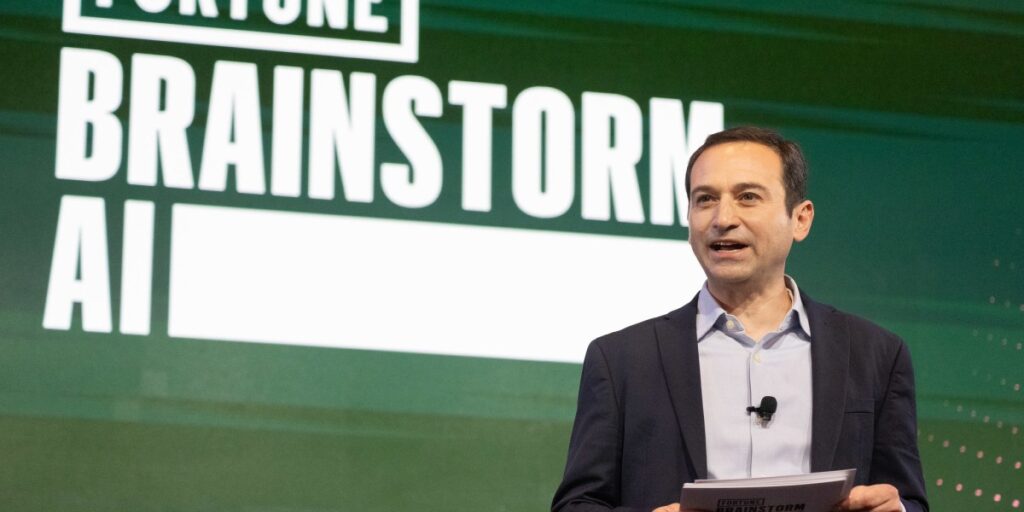What I learned at Fortune Brainstorm AI Singapore
AI adoption in Asia is charging ahead, despite challenges with AI agents and building “sovereign AI.”


Hello and welcome to Eye on AI. In this edition…China launches its own AI Action Plan…Meta hires an OpenAI veteran for new “chief scientist” role, raising questions about status of AI “godfather” LeCun…what if AI doesn’t speed up scientific progress?…and economists can’t agree on the impact AI superintelligence could have.
I spent last week in Singapore at Fortune Brainstorm AI Singapore. It was our second time hosting this event in the thriving city-state, and I was eager to find out what had changed since last year. Here are some of the key thoughts and impressions I took away from the conference:
The pace of AI adoption is equally fast everywhere. With previous technological waves, many Asian companies and countries lagged the U.S., Europe, and China in adoption. But that’s not the case with AI. Instead, the pace of deployment seems equally fast—and equally ambitious—everywhere.
Everyone wants AI agents. Few are actually using them yet. Everyone anticipated AI agents last year; now they’re here from OpenAI, Google, Anthropic, and others. Yet adoption still trails the hype everywhere. Why?
Agents, by their very nature, are higher risk than most kinds of predictive AI or generative AI that simply produces content. And right now, AI agents are often not that reliable. Some of the ways to make them more reliable—such as using multiple agents, each assigned a specific task within a workflow and with some agents assigned to check the work of others—are also expensive.
As a result, Vivek Luthra, Accenture’s Asia-Pacific data and AI lead, said that most businesses are using AI to assist human workers within existing workflows. In some cases, they may be using AI as an “advisor” to provide decision support. But few are automating entire workflows.
Luthra, however, predicts this will change dramatically. By 2028, he forecasts that one-third of large companies will have deployed AI agents, and that about 15% of day-to-day workflows could be fully automated. (Accenture is a sponsor of Brainstorm AI.) This is because costs will continue to come down, models will continue to become more capable and reliable, and more companies will figure out how to redesign workflows to take advantage of these new agentic properties.
AI’s impact on the job market is not easy to discern—yet. Pei Ying Chua, LinkedIn’s APAC head economist, told the conference that despite anecdotal reports that young graduates are struggling to find work, there’s not yet much evidence of this in the data on open roles that LinkedIn tracks. That said, there has been an uptick in the average number of applications required before coders land a job.
On the same panel with Chua, both Madhu Kurup, vice president of engineering at Indeed, and Sun Sun Lim, vice president at Singapore Management University, emphasized the need for employees to acquire both AI skills—techniques for prompting models, familiarity with how to build an AI agent, an understanding and of the strengths and weaknesses of different kinds of AI—as well as human “soft skills.” As AI transforms all jobs, soft skills like flexibility, resilience, and critical thinking matter more than ever, the two panelists said.
Jess O’Reilly, Workday’s general manager for ASEAN, said that she thinks AI will lead many companies to adopt an organizational structure based more around teams from diverse functional areas coming together for specific projects and then being reconfigured for the next project. She said this would be like an “internal gig economy” for employees. Traditional reporting lines and vertical organization would need to change in favor of a flatter, more dynamic org chart, she said.
Infrastructure is destiny. From several panels at Brainstorm AI Singapore, it was clear that access to AI infrastructure is going to be critical. This is true even when countries don’t want to build their own models. Just running models—what’s known as “inference”—also requires a lot of AI chips.
But building data center capacity requires big investments in energy. Rangu Salgame, CEO and co-founder of Princeton Digital Group, said that in the near-term fossil fuels, especially natural gas, would likely be used to power the data center buildout in Asia—which is not great news for climate policy. But in the medium-term, he saw great potential for AI data centers to force countries to build out renewable energy capacity, such as solar power and offshore wind.
Sovereign AI matters. Delivering it is challenging. Everyone is talking about the need for sovereign AI—and that was certainly the case in Southeast Asia, too. Governments want the ability to control their own destiny when it comes to AI technology and not become overly dependent on solutions from the U.S. and China. But achieving that independence is tricky, as was clear from several of the sessions at Brainstorm AI.
While increasingly capable open-source models are giving governments some options in terms of which models they choose to build their solutions on, there are still some big constraints.
First, there’s the huge cost of building out data center capacity and constructing the power plants and upgrading national grids to support it, which I mentioned above. Then there is the issue of training AI models that are adept at local languages and also understand cultural nuance. This requires curating data sets specific to local context, said Kasima Tharnpipitchai, head of AI strategy at SCB 10X, which is building an LLM for the Thai language. “There are no tricks here, you really have to do the work,” he said. “It really is just effort. It’s almost brute force.”
Embodied AI is China’s big strength. While it often looks like the U.S. and China are evenly matched when it comes to the capabilities of AI models, China has a massive advantage when it comes to “embodied AI”—that is, AI that will live in physical devices, from robotaxis to humanoid robots. That was the message from Rui Ma, founder of Tech Buzz China, who spoke on a fascinating panel looking at the geopolitics of AI. China controls almost the entire robotics supply chain and is making rapid progress creating cheap and practical robots designed for factories, as well as general purpose humanoid robots. (One of those humanoid robots—Terri, which uses software from Hong Kong startup Auki Labs, but whose body comes from Chinese robotics company Unitree—wowed delegates at Brainstorm AI.)
There is a middle path between the U.S. and China. Singapore has consistently tried to thread a path between the two superpowers. And at Brainstorm AI, the country’s digital minister Josephine Teo said that the country was finding places to act as a bridge between the U.S. and China. For instance, in late April, Singapore played a key role in hosting a meeting of AI safety researchers from both the U.S., China, and elsewhere that arrived at what is called the “Singapore Consensus”—an agreement that AI systems should be reliable, secure, and aligned with human values, as well as a shared vision about ways to ensure that is the case.
With that, here’s more AI news.
Jeremy Kahn
[email protected]
@jeremyakahn
Before we get to the news, I want to flag my most recent Fortune magazine feature on AI darling Perplexity. If you want to know why the “answer engine” company is now worth $18 billion and why tech giants from Google to Apple are watching its every move, please give the story a read.
Note: The essay above was written and edited by Fortune staff. The news items below were selected by the newsletter author, created using AI, and then edited and fact-checked.
AI IN THE NEWS
China calls for cooperation on AI governance and a new international organization. At the World Artificial Intelligence Conference in Shanghai, Chinese Premier Li Qiang called for a global governance framework to coordinate the development of AI and work towards agreed safety standards. He called for the creation of an international organization to coordinate AI efforts and warned against AI becoming an “exclusive game” for a few nations or corporations. He also called for cooperation on the buildout of data center capacity around the world, emphasized the importance of open-source AI models, and said that AI deployment should be “state led.” Li’s speech came just days after U.S. President Donald Trump unveiled his own AI Action Plan, which was designed to ensure the U.S. remains the dominant power in AI development. You can read more on Li’s speech from The Guardian here.
U.S. suspends AI hardware export control enforcement amid trade talks with China. The Trump administration has frozen planned restrictions on U.S. technology exports to China, including Nvidia’s H20 AI chip, in an effort to preserve ongoing trade talks and secure a meeting between U.S. President Donald Trump and Chinese President Xi Jinping. This reversal—prompted in part by lobbying from Nvidia—has sparked backlash from national security officials and experts, who warn the H20 chip could accelerate China’s military AI capabilities, particularly in areas like autonomous weapons and surveillance. You can read more from the Financial Times here.
Meta hires a new chief scientist amid AI hiring spree, forcing AI “godfather” LeCun to clarify his role at the company. Meta founder and CEO Mark Zuckerberg announced that he had poached AI researcher Shengjia Zhao from OpenAI and was appointing him “chief scientist” for Meta’s new Superintelligence unit. Zhao, who helped develop ChatGPT, is just the latest in a string of researchers Meta has hired away from rival labs, including OpenAI, Google DeepMind, and Anthropic as well as Apple. But Zhao’s title raised eyebrows among AI industry watchers as it is similar to the title long-held by Yann LeCun, the Turing Award-winner and “godfather” of AI who Zuckerberg hired back in 2013 to establish Meta’s Fundamental AI Research (FAIR) lab. LeCun, who has been openly skeptical that current approaches to AI will lead to human-level AI, let alone superintelligence, has been increasingly sidelined in Meta’s drive to develop AI models and products. LeCun was forced to issue a statement on LinkedIn clarifying that he has always been focused on long-term research into new AI methods at FAIR and that “my role and FAIR’s mission remain unchanged.” You can read more about Zhao’s hiring here in Tech Crunch and more on LeCun’s statement from Business Insider here.
Anthropic courts $150 billion valuation, even as expert warns copyright cases could jeopardize the company. Anthropic is in early talks to raise about $3 billion at a $150 billion valuation, the Financial Times reported. The amount is more than double the company’s March valuation, driven by surging revenue that is now running at a $4 billion annualized pace. But at the same time, Santa Clara University law professor Ed Lee published a blog post in which he calculated that if Anthropic loses the class action lawsuit it is facing over the alleged use of libraries of pirated books to help train its Claude AI model, the company could face “business-ending” damages totaling into the billions of dollars. For more on Lee’s analysis, see my Fortune colleague Bea Nolan here.
EYE ON AI RESEARCH
Will AI accelerate scientific progress or slow it down? Conventional wisdom is that AI is about to massively accelerate scientific progress. Indeed, hardly a week goes by without news of scientists using AI to help unlock some previously difficult or impossible task—from predicting the structure of proteins to controlling plasma in a fusion reactor. The latest example came last week with Google DeepMind unveiling an AI system called Aeneas that can pinpoint the date of Latin inscriptions—a boon to classicists and historians.
But Princeton University computer scientists Sayash Kapoor and Arvind Narayanan, who write a newsletter called “AI Snake Oil” that is deeply skeptical of much of the hype surrounding AI, argue in an essay published earlier this month that the conventional wisdom about AI and science is wrong. Rather than accelerating science, they contend, AI will slow it down.
Their argument rests primarily on AI’s ability to increase the volume of research papers being published, which makes it that much harder for scientists to find novel ideas. They also argue that AI’s ability to make accurate predictions without creating underlying theories of causation will actually decrease human understanding, not advance it. That second argument is one I also explore in my book, Mastering AI, and I think it is a real possibility. But, I think Narayan and Kapoor don’t give enough credit to AI tools such as DeepMind’s AlphaFold to rapidly expand the boundary of scientific discovery.
FORTUNE ON AI
Many students in China are choosing to learn AI mostly out of ‘guilt or shame,’ not because they enjoy it, study finds—by Sasha Rogelberg
Is a ‘pretty good’ Alexa+ good enough to pull off a comeback almost two years after Amazon’s revamped voice assistant was first announced?—by Jason del Rey
Walmart—yes, Walmart—says AI agents are its future—by Jason del Rey
Satya Nadella on the ‘enigma of success’ in the age of AI: A thriving business, but 15,000+ layoffs —by Nick Lichtenberg
AI is driving mass layoffs in tech, but it’s boosting salaries by $18,000 a year everywhere else, study says—by Nino Paoli and Nick Lichtenberg
Agentic AI systems must have ‘a human in the loop,’ says Google exec—by Sheryl Estrada
AI CALENDAR
Sept. 8-10: Fortune Brainstorm Tech, Park City, Utah. Apply to attend here.
Oct. 6-10: World AI Week, Amsterdam
Oct. 21-22: TedAI San Francisco. Apply to attend here.
Dec. 2-7: NeurIPS, San Diego
Dec. 8-9: Fortune Brainstorm AI San Francisco. Apply to attend here.
BRAIN FOOD
What would AI superintelligence do to the economy? That question is increasingly being debated among economists as more AI companies begin to talk about artificial superintelligence (ASI) as achievable in the next decade. The Economist has an excellent feature covering the various and contradictory views of economic experts. If the AI boosters are right, almost all economic value will accrue to owners of capital. But some funny things can happen during the transition—with wages for workers who are still employed going up, not down. One thing that is clear from the analysis is that, so far, the financial markets, for all their enthusiasm about companies such as Nvidia that are closely linked to the AI boom, are discounting the likelihood of ASI. The whole article is well-worth a read.






